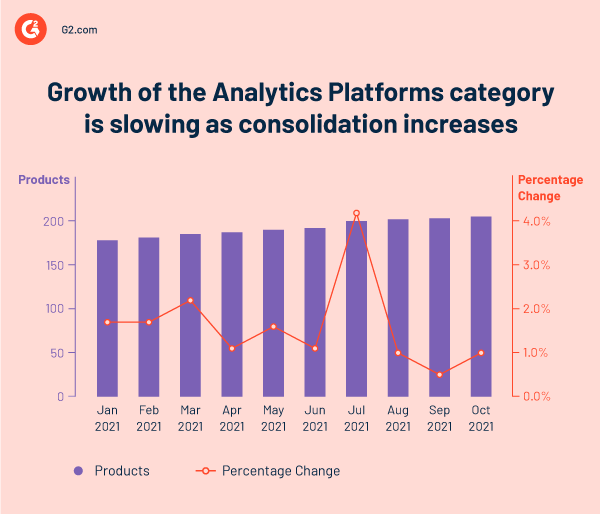This post is part of G2's 2022 digital trends series. Read more about G2’s perspective on digital transformation trends in an introduction from Tom Pringle, VP, market research, and additional coverage on trends identified by G2’s analysts.
2022 will be the year of putting data at the center
2022 TRENDS PREDICTION
The coming year is when data will be in the limelight. Data will no longer be something that boosts the effectiveness of companies or something which aids their success, instead, it will determine their success.
We’ve all heard the phrase: Data is the new oil. We might have even heard other clever descriptions of data—data is the new gold, data is the new currency, etc. Heck, I have even compared data to musical notes, which can be interpreted and understood as a beautiful symphony or a cacophony of individual notes.
However, in order for companies to succeed in this data-driven era, they will need to shift their mindsets for 2022, when data will be more crucial than ever before. Therefore, it is imperative that that data is properly managed, monitored, modeled, and mined for insights.
The development of the following elements are fueling this trend:
- Understanding the place of dashboards
- Conversational interfaces (providing the ability to talk to your data)
Dashboards are not dead
Data visualization and insight generation have remained fairly static over the past couple of decades. Dashboards have ruled supreme, which allows users to display metrics of their choice and create multiple views of analytics related to specific teams or initiatives, in the form of pie charts, line graphs, and more. On G2, 251 of our categories have dashboards as a feature, ranging from marketing automation software to payroll software.
Since 2020, as the graph of Google searches displays below, dashboards have become increasingly more popular.
On the flip side, people have been throwing around the concept of “the death of the dashboard” for years. The common complaint has been that with the proliferation of data, dashboards have become unruly, with too many data points to be able to track and manage at any given moment.
However, at G2, we believe that dashboards are here to stay. That being said, they should be the jumping-off point for data analysis, providing the business user with a birds-eye view of their data. From this starting point, they should be able to dig in and drill down, through conversational interfaces, search, and natural language generation.
Hello data, my old friend: Talking to your data
Last year, I predicted:
“With the rise in interest in this sort of conversational technology (chatbots software and intelligent virtual assistants software), we also think this type of intelligence will trickle down into other software areas, such as analytics platforms. Although some provide some degree of natural language search, we think that 2021 will be a year in which business users will engage in an even more conversational manner with these platforms.”
We have seen this prediction come to fruition, and believe it to only increase. For example, in November 2021, we saw ThoughtSpot (Leader in G2’s Analytics Platforms Fall Report) announce their $4.2B evaluation, after having raised $100 million. ThoughtSpot notes that dashboards are dead and presented their notion of “Live Analytics” as an alternative, providing the user the ability to engage with live data and to search for answers, ask follow-up questions, and drill down into data. In 2021, we added this important feature as a filter to the Analytics Platforms category, allowing buyers to find tools that allow the user to search through their data in order to derive insights from it.
We would like to tweak their pronouncement regarding dashboards to “dead dashboards are dead”. That is, dashboards that do not facilitate further data discovery and the ability to drill down into data are not useful. To fully understand company data, stale, old dashboards will not cut it. Instead, they must be tools that provide overall knowledge and provoke questions. From these questions, users will be able to search their data for insights and anomalies, and more.
When data talks back: having a two-way conversation
Although being able to ask questions of one’s data (such as “how are my salespeople in Texas performing compared to those in California”) is critical, the types of answers that the software provides are perhaps just as important.
Therefore, we believe that just as one should be able to ask intelligent questions about their data, the software should be able to provide intelligent answers. These answers can come in the form of suggested visualizations, auto-generated reports, and more. In regards to auto-generated reports, we believe that this will be a growth area for 2022.
In 2021, we saw the acquisition of Narrative Science, a data storytelling startup, by Tableau, which is owned by Salesforce. Although Narrative Science already had integrations with Tableau (providing natural language summaries of dashboards), CEO of Narrative Science Stuart B. Frankel noted that they are looking to integrate with other Salesforce products, such as Slack. With this integration, users would be able to have robust back-and-forth conversations with their data, right from their collaboration tools.
In 2022, we expect that these conversational interfaces will become increasingly more popular. With the Analytics Platforms category on G2, we are seeing that although the number of products is increasing, it is growing at a slower rate than at the beginning of the year. In 2022, this rate will likely remain the same or even decrease as consolidation as the market continues. Current players will continue to develop conversational and search features through research and development and acquisitions.

Data is not oil, it’s the brain
In the business world of 2022, data must be thought of as the brain of the business. Oil is expendable and can be swapped with other power sources, but one can’t live without a brain. When businesses are built with data at their core, as most modern businesses are, it is fundamental that that data can be seen clearly via well-built dashboards.
However, the journey can’t end there and must move to fruitful conversations and useful suggestions from the software. With robust, conversationally-enabled analytics solutions in place, businesses can look to the future with confidence.
¿Quieres aprender más sobre Plataformas de Análisis? Explora los productos de Plataformas de Análisis.

Matthew Miller
Matthew Miller is a research and data enthusiast with a knack for understanding and conveying market trends effectively. With experience in journalism, education, and AI, he has honed his skills in various industries. Currently a Senior Research Analyst at G2, Matthew focuses on AI, automation, and analytics, providing insights and conducting research for vendors in these fields. He has a strong background in linguistics, having worked as a Hebrew and Yiddish Translator and an Expert Hebrew Linguist, and has co-founded VAICE, a non-profit voice tech consultancy firm.
